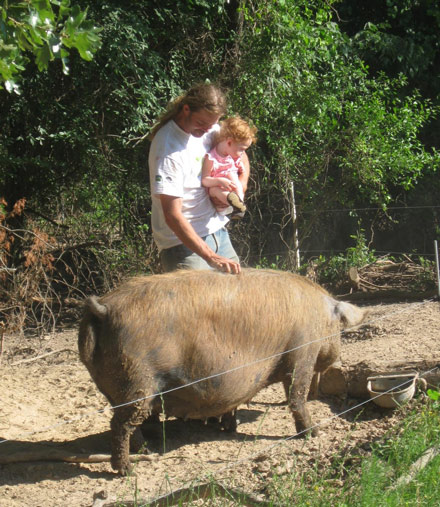Editor's note: Author Jeremy Prater is a farmer with Heifer's USA Program in Arkansas. His article originally appeared in the FAO's Perspectives series last week.
The reasons my family farms are many and varied. The obvious are the days spent working in one of the most beautiful places in the world, the landscape of our farm surprising us with new growth and increased diversity every year; the feeling of connection to our land and our community as we work the booth at the Farmer’s Market. We have been doing this for three generations and are now raising the fourth.
But farming is not just strolling through the pastures picking daisies and listening to birdsong while the animals quietly graze. There are the freezing days, the scorching days, the days where everything breaks at once. These days can add up and try our spirits so strenuously that giving in and giving up would be a relief. The days where everything feels like a battle unfortunately tend to outnumber the days where the wind feels like the breath of god on your skin. This is not a complaint, however. It just means that we are necessarily driven by motivations other than the pleasures of farm life to continue the tradition of family farming.

One of these driving forces is that with our work, we can see firsthand that we are making the world a better place. It may just be a small part of the world, but as John Muir famously noted, "When we try to pick out anything by itself, we find it hitched to everything else in the Universe." We are motivated to be responsible family farmers because if we do the right thing on our patch of land and others do the right thing on their patches of land, all these positive actions will connect through this web, and the Universe will be uplifted.
Through our farming activities, we improve biodiversity, preserve wild areas, improve the condition of the grasslands, build the soil and keep our water clean. Because we have our feet and our eyes on our farm every day, we can make small adjustments to how we operate to ensure that our activities are sustainable and our impact positive.
In fact, many small, independent farms like ours represent both biodiversity and social diversity. The health on our farm, and all sustainable farms, is judged by the increasing amount of species—wild or farmed—the more diversity, the healthier and more resilient the farm. Biologists like E.O. Wilson describe the environment as such an immensely complicated system as to keep biologists fully employed for centuries to come; that in general, an undisturbed environment is functioning at its peak efficiency.
As farmers clear land, plant and introduce animals, we are decreasing that land’s ability to turn sunlight into substance at its most efficient level. As a sustainable farmer, I seek to come as close as possible to that first, native level of efficiency, which means doing as little as possible to modify that environment, and in so doing create a stronger more profitable farm.
We are connected deeply to our community as an economic engine, a place of employment, a source of food. Socially, small farms mirror nature by adding one more layer of diversity to our communities, making the community more resilient and adaptable.
There are other reasons we continue to farm. We farm in order to feed our community healthy, humanely raised meat. We farm to sequester what carbon we can in the soil. We farm to minimize the impact of our existence as humans on this beautiful Earth. We farm to teach our children the value and fulfillment of hard work. We farm to teach our community the value of food raised right.
So on the days when all the waterlines are frozen, or the chickens need to be misted every hour so they don’t die from the heat, the calf is stillborn, or the electric fence is down and the goats get out and eat the apple saplings, we can take a deep breath and sift through our many and varied reasons for farming to find the one that gives comfort that day.
Whether it’s watching our customers’ children grow bigger every year at the farmers’ market, or watching our own child hold and pet a baby chick with care and awe, or seeing painted buntings for the first time in years, or just sitting down to a dinner that we ourselves created, there are so many reasons that family farming is a beautiful thing, both for the farmers and for the Universe.
